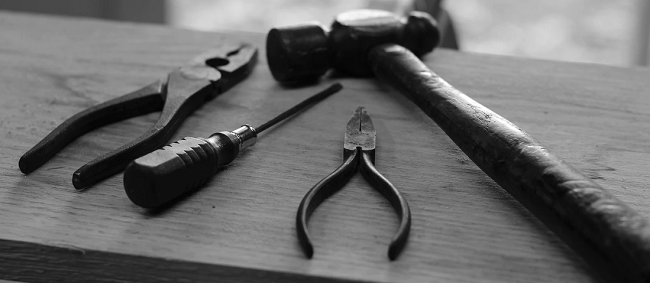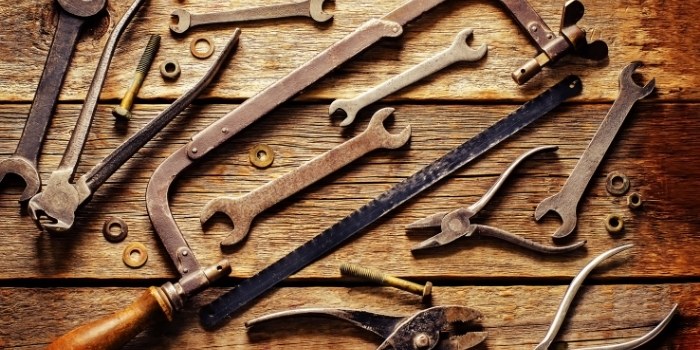The usage of metal tools is common in homes as well as in industries. Being made of metals (like iron and alloys), these tools get rusted quite often – when exposed to humid air or kept idle for long. And if left unnoticed for long, simple to clean rust can get complex – destroying your tools forever.
In most cases, a rust deposit is a sign of wear and tear. It can develop on any metal object like your garden tools, outdoor iron furniture, car parts, etc. Even when you have stored them safely in a place with no moisture or condensation, there are still chances that these tools and equipment may get corroded.
For professionals and DIYers at home, rusted metal tools are hard to use and can pose the risk of getting an infection. These can also cause injury to your body parts when used without cleaning. Therefore you must take proper action to get rid of rust as soon as you find it developing on your tools.
Below we provide detailed instructions to keep your iron tools safe from rust. Also, we will learn how an ultrasonic cleaning machine can help remove rust very easily without paying hefty amounts for professional cleaning services. Let’s check them out…
Removing Rust with Ultrasonic Tool Cleaner
Ultrasonic cleaner is one of the best technological inventions, and it works to clean your old rusted tools, metals, and other objects within no time. According to reviews, people who have already tried it for cleaning their old iron tools are more than happy with the outcome they achieved without paying any hefty charges.
These automatic cleaning devices use high-frequency sound waves to remove contaminants such as rust, paint, grease, and oil from antique tools and metal surfaces when the tools are immersed in liquid or cleaning solvent.
With the cavitation effect and pressure caused due to the varied frequency, the dirt and rust particles break up in the sonic machine, making your tools clean.
Depending on the requirement you can employ it both for home use or as a large-sized commercial-based unit for industrial use.
What solution to use?
For rust removal using an ultrasonic cleaner, you’ll need a solution specifically designed to loosen and dissolve rust without damaging the tool’s material.
Worry not, as many manufacturers offer ready-made ultrasonic cleaning solutions tailored for rust removal. These are also special additives that not only remove rust but also convert it into a protective layer, preventing further corrosion.
But in general, you should look for one that is acid-based or contains chelated rust removers for effective rust breakdown. It should also be safe for your tool material (check compatibility, especially for aluminum or softer metals).
Procedure – how to go about it?
- Dilute the solution and pour it into the machine.
- Set the ultrasonic cleaner to about 50–60°C (122–140°F) for better results.
- Allow the tools to soak for 10–20 minutes depending on the severity of the rust.
- Post-cleaning rinse the tools thoroughly with water and dry them completely to prevent re-rusting.

What Type of Tools Can You Clean in Sonic-Cleaner?
Working or construction tools can be broadly categorized into two types: hand tools and power tools.
Hand tools, such as hammers, wrenches, pliers, and screwdrivers, are commonly used in households and woodworking. On the other hand, power tools, which are electrically operated—like electric drills, saws, circular saw blades, and sanders—are primarily used by professionals in industrial settings.
Woodworking tools, often used for cutting materials like pine or MDF, can accumulate resin build-up over time. Removing this resin manually can be a labor-intensive process. However, with an ultrasonic tool cleaning device, the process is significantly faster, reducing cleaning time to just a few minutes.
So, when it comes to thoroughly cleaning tools using a sonic device, simple hand tools are suitable for direct cleaning. However, power tools, which contain mechanical and electrical components, are not designed to be immersed in water-based ultrasonic solutions as this may cause damage.
Instead, it is recommended to disassemble power tools and clean specific parts, such as those from profile cutter machines or CNC machines, that are heavily contaminated or rusted.
How to Clean Old Rusty Tools Without an Ultrasonic Cleaner
Keeping your prized metal tools and equipment safely in a dry condition is most important, especially at times when you do not want to use them for the time being.
However, if you are a bit skeptical about whether or not ultrasonic sound waves help in cleaning, let me tell you that many other household methods can be employed. Let’s discuss some of the most effective methods here…
1- Scrubbing with Sand Paper or Scotch Brite
Sandpapers are commonly used by carpenters and mechanics to scrape rust from metal hand tools. While they may be effective in certain situations (where the rust layer is very thin), relying on sandpaper for rust removal is not always the best idea, as it can potentially damage the surface of the tools.
This is especially true for expensive metal tools with a thick layer of rust. Scraping such tools with sandpaper can leave scratches or abrasions on the surface, which may compromise their functionality and appearance. In severe cases, excessive scrubbing can even lead to permanent damage, leaving you with no option but to replace the tools entirely—a costly and avoidable scenario.
Similar to sandpaper, the Scotch Brite scrub pad that has been used in the kitchen is one of the best ways to keep the tools rust-free.
You can soak your metalworking tools in a diluted cleaning liquid (like a Dawn dishwash soap) and then try scrubbing the tools using Scotch Brite. Just be ensured that you do not scrub the tools too hard as they may get damaged forever.
2- White Vinegar Method for Rust Removal
Often it has been seen that carpenters and other hand tool users use the solution of salt and vinegar for cleaning the rust off metal tools. This is also one of the best ways for gardeners who want to clean their rusty garden tools using a DIY natural homemade method.
To prepare the solution for mild rust, mix equal parts of vinegar and water (1:1 ratio) for optimal results. As an alternative, you can dissolve citric acid powder in warm water (about 2–3 tablespoons per liter) or for very lighter rust, mix baking soda with water to form a slightly alkaline solution.
Many also use rust-cleaning agents like baking soda, ketchup, coke, lemon, etc., to get the job done. However, I recommend that you use them at your own risk as these are not meant to get the best desirable results.
3- Restore Old Rusty Tools with Rust Removing Liquids
Rust-removal liquids and sprays, like WD-40, are excellent for cleaning mildly rusted tools. For tougher, older rust, stronger cleaners like lime and calcium removers may be required. Just make sure that you follow the instructions provided on the package of liquid so that it does not cause any further damage to your metal tools.
Remember that significant rust and other weather damage can blunt tools and cause them to be ineffective. Also, the more rusted a tool or product is, the harder it will be to clean, and the more important it is that you clean regularly.
Before picking any solution, it’s important to choose a product suited to the severity of the rust. Also, check whether you need a product to clean hand tools or power tools so that you can get everything in your garage looking as it should.
Here are the instructions for cleaning your hand tools and power tools using WD-40 Specialist Degreaser:
- Begin by preparing the tools for cleaning by removing any dirt, grease, or debris with a cloth or brush.
- Next, spray WD-40 Specialist Degreaser generously over the rusted or greasy areas of the tool and let it sit for 5 to 10 minutes to break down the rust or grime.
- Once the degreaser has settled, gently scrub the affected areas with a soft-bristle brush, steel wool, or a scrub pad, being careful not to apply excessive pressure that could damage the surface.
- Wipe the tool clean with a dry cloth to remove any residue.
- If stubborn rust or grease remains, repeat the process as needed.
- After cleaning, apply a light coat of WD-40 Multi-Use Product to the tool’s surface to protect it from future rust and corrosion.
If you need to clean power tools, ensure safety by disconnecting the power tool from its power source and removing any batteries. If necessary, disassemble parts to focus on cleaning non-electrical components then:
- Spray WD-40 Specialist Degreaser onto the metal or greasy parts, being careful to avoid spraying directly on electrical components.
- Let the solution sit for a few minutes to loosen rust and grime.
- Use a cloth or a gentle brush to clean the treated parts, scrubbing harder only if the rust or grease is particularly stubborn.
- Use cotton swabs or small brushes to clean hard-to-reach areas.
- Once cleaned, ensure all parts are thoroughly dry before reassembling the tool to prevent electrical hazards, and apply WD-40 Multi-Use Product to the metal parts for rust prevention and smooth operation.
How to Keep Tools from Rusting – Tips to Prevent Rust on Metal Naturally
Old metal tools that are passed on to you by your father and grandfather are one of your prized possessions. But the quality and efficacy of the tools which were mind-blowing then, may not be the same due to their corrosion and long-term usage.
The fact is, today you don’t get such high-quality parts and tools in the market. So, keeping them in a good healthy condition is a task you can accomplish. All you will need is a bit of care & maintenance with some love and affection.
To prevent your tools from getting rust, do not forget to clean them up immediately after use. Especially when your tools are made up of corrosive metals (like iron, stainless steel, copper, bronze, aluminum, and other alloys), you should make sure that you give it a look at least once a month to ensure that moisture has not made its way into the pack in which you have stored your tools.
If someone has borrowed the tools from you, get them back once the work is done, and follow these maintenance steps to keep them rust-free and away from oxidation:
- Using WD-40 or similar sprays regularly can help prevent significant rust buildup, which can dull tools and reduce their effectiveness.
- Next, wipe the tools clean with a soft cotton cloth after every use. This will eliminate the chances of corroding due to moisture left behind, if any.
- After wiping them clean, store the tools in a safe dry place. There should be no way to get condensation to find its way.
- If possible, you should pack them safely in plastic bags with silica pouches. With silica gel packets, you can rest assured that there is no moisture to corrode your tools – these desiccant packs automatically absorb the moisture in the air to keep things dry.
If you have followed the above steps, then you can be sure that your construction tools will last long without any tension. However, if your tools are showing the first signs of corrosion, it is high time to get them cleaned properly. Follow the steps above and use an ultrasonic tool cleaner to make sure that your precious tools are safely cleaned and stored.


